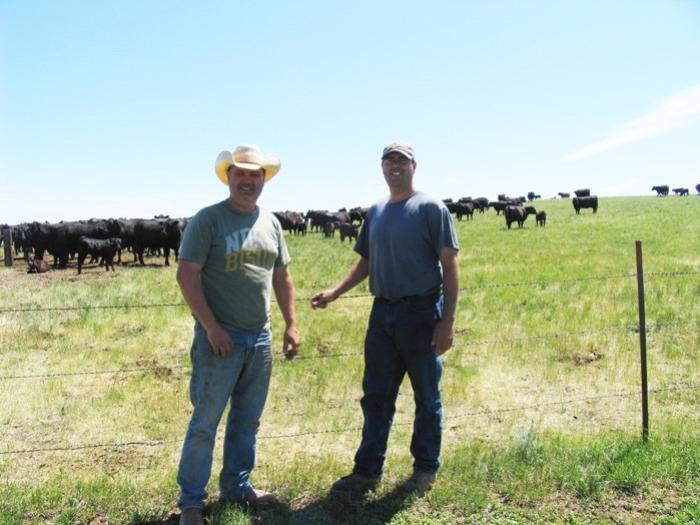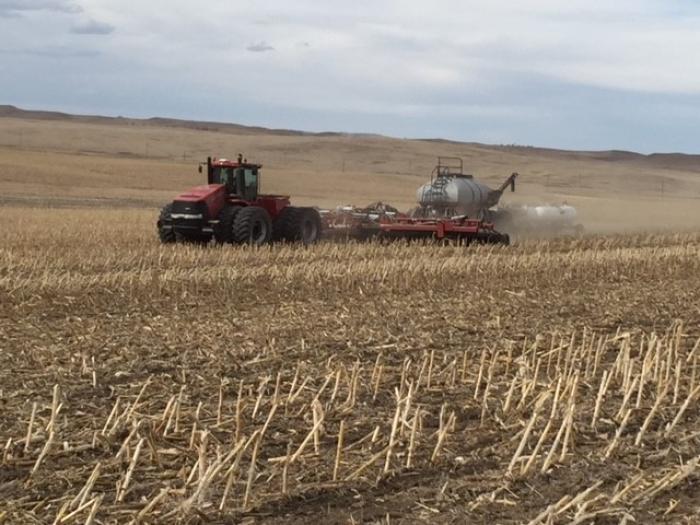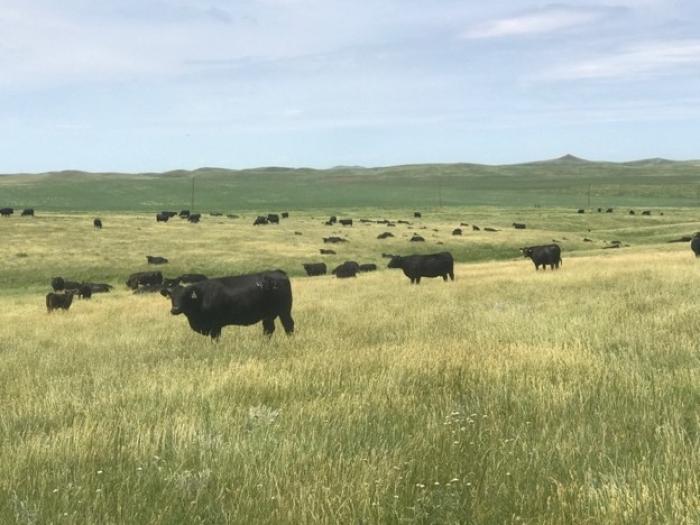Grant County: Building on conservation practices helps Blue Hill Ranch become more sustainable
As fourth-generation farmers and ranchers now raising their own families where their great-grandfather homesteaded in 1906, brothers Clair and Jamie Hauge understand sustainability.
Luann Dart writes from Elgin, N.D.
“Sustainability means different things to different people. For us, we may own the deed, but it’s not ours. It’s God’s,” Jamie says.

North Dakota State University graduates, both brothers worked away from the farm and ranch operation before returning. Jamie, the oldest, returned in 2000 and Clair in 2004. They now have a formal partnership to operate Blue Hill Ranch, a cropping and cattle enterprise.
“The great part about our operation is that Jamie and I each have a passion and they’re not the same passion. His passion is livestock and mine is cropping. It works out very well. We run our operation as one operation, but we have two intensive managers on each enterprise,” Clair describes.
They raise wheat, corn, sunflowers, chickpeas, forage peas and alfalfa, along with growing cover crops and forages annually. The operation also raises registered Angus cows, operates a feedlot and oversees an embryo transfer program.
Blue Hill Ranch, located in Grant County near Carson, N.D., started using the Great Plains Conservation Program when Jim Hauge began rotational grazing as early as 1986. The brothers have continued using the Environmental Quality Incentives Program (EQIP) through the Natural Resources Conservation Service (NRCS) to advance their farming and ranching practices, as well as the Conservation Stewardship Program (CSP), which encourages conservation enhancements.
Clair’s goals for the cropping enterprise include obtaining positive, strong yields; eliminating erosion; and building organic matter. No-till practices and crop rotation are a large part of reaching those goals, he says.
100% no-till
Clair began using no-till fully in 2010, after having used minimum one-pass tillage in the past.
“It comes down to moisture retention and moisture is the biggest issue where we live, so moisture retention is number one, and to keep the cover on the ground and to keep a layer of mulch, not disturb the soil, have better water penetration, all those go along with it,” he explains.
“We’re growing much better crops than we did previously,” he says. “It takes a crop rotation to go along with no-till. It’s a system approach.”
The crop rotation includes one-third of the land in wheat, one-third in corn and one-third in a broadleaf crop each year, using a three-year rotation schedule.
High-residue crops left on the surface are slowly rebuilding organic matter in the soil.
“It’s a very slow process to build organic matter,” Clair says. “We’ve seen some very nice improvements to the soil in different ways.” Soil has become more mellow and workable and the earthworm populations has increased, he points out.
“The biggest game changer that goes along with the no-till is the advent of grain corn in this area. That has been a huge deal for us,” Clair says. “It’s a huge synergy between the livestock and the grain operation. It allows us to not only use the grain if we would like to feed it at our feedlot, but it allows the grazing.”
Clair says they probably couldn’t have made the changes without NRCS.
“They sponsored no-till conferences and had some of the expertise to gather farmers together to visit about what people are doing and share ideas,” he says. “The sharing of ideas makes it a lot easier.”
“The Hauges are highly knowledgeable on conservation-related activities and their effects,” says Edward Bahm, a district conservationist with the NRCS Carson field office. “I am impressed with their commitment to try new conservation practices, as they actively try to improve on already adopted practices. Their efforts are resulting in more sustainable agricultural production to help feed people, but also at the same time improve environmental quality. I feel fortunate for the opportunity to work with the Hauges on their operation,”
Zone management

Three years ago, the Hauges began developing zone mapping and using variable rate fertilization and seeding based on the maps.
“You need a lot of data to do that and we’re in the infancy stage of gathering that data,” Clair says, as they develop zones using yield maps, satellite mapping and soil maps. “It takes a lot of data and a lot of history to build that zone to perfection.”
Using Farm Works software, they download yield maps from the combine and then develop three to four zones to apply seed and fertilizer, focusing on pushing yields in better soil and downplaying poor soils.
“In western North Dakota, you’ve got lots of hills and the tops of hills don’t do very well normally, so it doesn’t pay to put a lot of extra on those spots,” Clair says.
Blue Hill Ranch is also using sprayer overlap controls, so the nozzles will turn off at an overlap of more 20 inches, and a drift reduction component to match the droplet size to the wind speed.
“That’s a cost savings for us. You’re not over applying, because over application can be harmful a lot of times,” Clair says.
Another synergy between the crops and livestock is fencing the cropland so cattle can graze residue and cover crops well into the winter months.
“If we get into a dry year, at least we have enough grass to make it into the middle of July on any given year, then we can go into fields if we have to,” Jamie shares.
Cover crops for grazing

The brothers are experimenting with cover crops, planting both fall and full-season cover crops for grazing. “That’s where the relationship between the cropping enterprise and the cattle enterprise shines is when we can utilize that for grazing of some sort,” Clair says. “We’re trying to figure out what system works the best.”
As the cattle rotate through the pastures, the cover crops are included in the rotation, with cattle entering the cropland for a short time before being rotated back to the pasture.
“The goal is to take half, leave half. The whole system is take half, leave half,” Jamie says.
“If you season-long graze or overgraze, you never develop that root structure,” Jamie says.
“Roots are a big component of building that organic matter,” Clair adds.
Jamie uses a twice-over rotational grazing system which includes five systems, with 150 to 300 cattle in each system. There are 75 different pastures within the five systems. Cattle graze from three to five days the first time in a pasture and from five to eight days the second time through.
“Thirty-two years and we have a lot to learn, because every year is different and we continue to learn,” Jamie says. “We’re always refining our systems.”
One of those refinements includes never entering the same pasture two years in a row in the spring. They also use flash grazing in the spring or fall to decrease the amount of Kentucky bluegrass in the pastures.
Over the years, Blue Hill Ranch has installed 21.75 miles of underground water pipeline and 69 water tanks, as well as 20 miles of cross fencing.
“We have fresh well water in every pasture through pipeline,” Jamie says.
The rotational grazing has helped preserve and sustain pastures.
“Our cows are only in a certain pasture for 10 to 15 days for the entire year. That’s allowed that root structure that Clair and I are huge on, it allows that plant to put more root structure down which in a drier year allows more tons of grass to be produced. When you have heavy rains, you have better infiltration. Wildlife has flourished since we have started doing more intensive rotations,” Jamie says.
“That root structure also allows that grass to bounce back faster when you do get those rains like last year,” Clair adds.
By preserving that root structure, Blue Hill Ranch has increased its stocking rate by 25% in the last 15 years.
“We’re producing more pounds of beef on less acres,” Jamie says.
Jamie keeps a handwritten journal scrawled with rotation dates, but his main indication is the grass itself, rather than mandatory dates.
And both know that sustainability requires patience.
“The benefits aren’t the first seven to eight years, it’s 20 years,” Jamie says.

